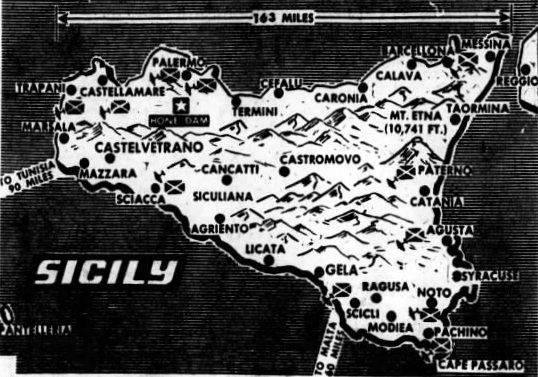Brooklyn Eagle (July 12, 1943)
10 Sicily ports fall; Allies gain 15 miles
4,000 seized as Axis fails in 7 attacks
Allies make headway
After a series of fierce engagements with Axis troops in Sicily, Allied headquarters today announced the capture of ten strategic towns, including Syracuse, Noto and Gela along the southeast and southern coasts.
Allied HQ, North Africa (UP) –
Allied invaders captured 10 major towns in southeastern Sicily, repulsed seven armored counterattacks, took 4,000 prisoners and rolled at least 15 miles inland today in a smashing offensive for conquest of the Italian island bastion.
Led by tanks and paratroopers and strongly supported by naval and air bombardment, the Americans under Lt. Gen. George S. Patton Jr. seized the big air base at Licata on the south coast and the British under Gen. Sir Bernard L. Montgomery took the vital port of Syracuse, to consolidate a 100-mile coastal invasion strip.
Patton’s tough U.S. units broke up a heavy Italian counterattack headed by 45 Fascist tanks just north of Gela and then repulsed the heaviest of seven enemy counterattacks by turning back the Italian 4th Livorno Division in hard fighting.
“The advance continues,” today’s communiqué from Gen. Dwight D. Eisenhower stated and dispatches from forward areas described the offensive as moving into high gear against stiff Axis opposition.
The population of Sicily was described as “showing great friendliness” toward the invasion forces and as being willing to cooperate, indicating that the conquest might be facilitated by the Sicilians.
The Allies are now astride the vital road running from Pozzallo, which surrendered to an Allied destroyer, to Syracuse, which British and Canadian troops stormed and took Saturday. They were opposed by the Italian 54th (Napoli) Division, based near Syracuse.
Allied casualties were still described as comparatively light.
Axis broadcasts and communiqués continue vague except to claim that there was bitter fighting on Sicily and that counterattacks had defeated the Allies at several points. The enemy claims hits on three cruisers and said that eight ships had been sunk.
Strong winds on the first night of the invasion caused difficulty for Allied paratroops, who were scattered more widely than intended. They got together, however, in sufficient force to reach the first planned objective. They were later driven off by the enemy but succeeded in making contact with invading ground troops and made a new stand.
The point of greatest penetration by the Allies appeared to be Rosolini, about 15 miles inland on the southeast coast, but dispatches reported a “deep penetration” at several points.
Air fleets of the United Nations, meeting slightly increased Axis air opposition, destroyed about 50 enemy aircraft to maintain aerial superiority above the invasion forces and strike with heavy bombloads at Axis front and rear bases in Sicily and lower Italy.
Allied naval forces continued to disembark reinforcements and supplies and destroyers bombarded the Sicilian coastal town of Pozzallo and the railroad line between Syracuse and Ragusa, on the east coast.
Vital towns seized
The towns captured included important ports and air bases in a 100-mile strip along the southeastern coast of Sicily from Syracuse around the corner of the island to Licata in the west.
The towns captured were:
- Syracuse, one of the important ports and communications centers south of Catania;
- Avola;
- Noto, which is on the railroad a few miles inland and south of Syracuse;
- Pachino, an air base on the southeastern tip;
- Scoglitti;
- Gela, an air base on the south coast;
- Licata, an air base and coastal city;
- Ispica;
- Rosolini, 15 miles inland;
- Pozzallo.
Yanks took Licata
U.S. forces captured Licata, one of the main enemy air bases on the central sector of the south coast, and ran up the Stars and Stripes over the harbor. The Navy immediately began pouring reinforcements and supplies into the port.
The surrender of Pozzallo was accepted by the commander of an Allied destroyer early Sunday afternoon.
The Allied advance generally continued, it was announced.
The communiqué from Gen. Dwight D. Eisenhower said:
Few details are available on the work of the Navy during the past 24 hours. The task of disembarking troops and their supplies on all beaches continues according to plan.
Weather improved
On the whole, weather conditions have improved, though the enemy’s interference from the air has been on a slightly increased scale. Defended areas near the coast town of Pozzallo, 12 miles westward of Capo delle Correnti, and the railway line between Syracuse and Ragusa, were bombarded last night by our destroyers.
The communique, giving the most complete picture so far of the invasion, made it clear that the main communications lines in southeast Sicily were largely in Allied hands, opening the way for a pincer drive from the Licata-Gela sector and the Syracuse region, which would be preliminary to moving northward toward Messina.
Shore bases in ruins
U.S. pilots returning from machine-gunning and wrecking hundreds of troop-filled trucks on the island said that large sections of the Island coast were “crumbling, smoking ruins” as a result of steady aerial bombardment.
Damage to Messina is “terrific,” one pilot said, and the port can probably be used only by small boats at night.
The Allied air attack had chased the enemy from his advanced airdromes and it was believed that from now on, the main Axis aerial operations would be from southern Italy, where Allied bombers heavily attacked the main Fascist air bases.
There was still no word of the Italian fleet going into action.
The BBC broadcast unconfirmed reports that part of the Italian fleet had put out from the Spezia Naval Base.
The Stockholm Social-Demokraten quoted a “German radio station in Sicily” as saying that the east coast port of Syracuse, only 33 miles below Catania, was threatened seriously by Allied troops who occupied several points to the south. Heavy fighting raged throughout the day near the south coast port of Licata with Allied efforts to penetrate to the interior being frustrated, it was said. An Allied landing attempt near Marsala in western Sicily was repulsed, the dispatch added. Several morning newspapers in Stockholm quoted Radio Bern as saying that an Italian naval force had left Spezia.
Field reports indicated that U.S., British and Canadian troops were gradually meeting increased resistance, but nowhere heavy enough to stem their advance. The bulk of the estimated 400,000 Italo-German defending troops were believed still concentrated in the center of the island.
Allied reinforcements, both of men and armor, poured onto beaches along a 100-mile strip of the southern and eastern shores of Sicily in a constant stream from landing barges comprising part of the giant armada of over 2,000 vessels, more than twice the 850-ship fleet that landed Anglo-American troops in Algeria and Morocco last November.
Beachhead widened
The London Daily Mail said that the Allied front in Sicily had been widened to 150 miles by the establishment of an important bridgehead by Canadians near Porto Empedocle, 27 miles northwest of Licata.
The Daily Telegraph reported from Zürich that Carlo Scorza, General Secretary of the Fascist Party, called an urgent meeting of the party directorate Sunday night while Premier Mussolini called on King Victor Emmanuel to address the nation, presumably in an effort to rally the Italian people behind the defense of their homeland. The dispatch also said that a great number of persons had been arrested in a drive to stamp out gossip in Naples.
A Stockholm dispatch to the Daily Telegraph quoted a traveler just arrived from Berlin as saying that German troop trains were streaming southward through the Brenner Pass. The remnants of “a Hermann Göring division,” he said, were flown to Sicily from Reggio Calabria.


